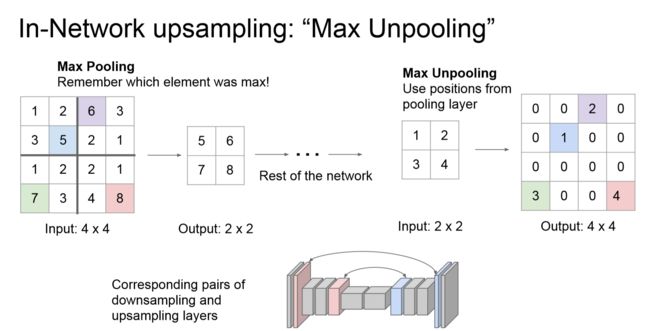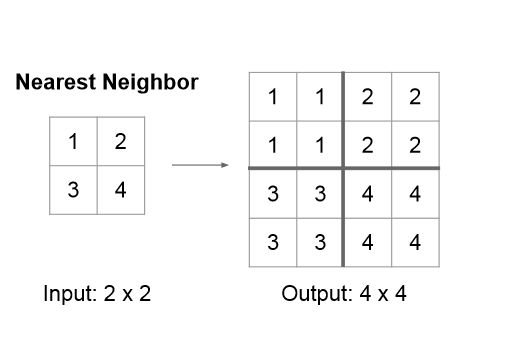上采样 介绍 + Bilinear pytorch代码解析
上采样
上采样,任何可以让你的图像变成更高分辨率的技术。
最简单的方式是重采样和插值:将输入图片input image进行rescale到一个想要的尺寸,而且计算每个点的像素点,使用如双线性插值bilinear等插值方法对其余点进行插值。
- Unpooling
在CNN中常用的来表示max pooling的逆操作。因为max pooling不可逆,因此使用近似的方式来反转得到max pooling操作之前的原始情况:
-
Deconvolution(反卷积)
- 也被称为分数步长卷积(convolution with fractional strides)或者转置卷积(transpose convolution)或者后向卷积backwards strided convolution。
- 与Unpooling不同,使用反卷积来对图像进行上采样是可以习得的。通常用来对卷积层的结果进行上采样,使其回到原始图片的分辨率。
Pytorch
在PyTorch中,上采样的层被封装在torch.nn中的Vision Layers里面,一共有4种:
① PixelShuffle
② Upsample
③ UpsamplingNearest2d
④ UpsamplingBilinear2d
upsample
torch.nn.functional.upsample(input, size=None, scale_factor=None, mode='nearest', align_corners=None)
推荐使用interpolate
- scale_factor 在高度、宽度和深度上面的放大倍数。
- mode 上采样的方法,包括最近邻(nearest),线性插值(linear),双线性插值(bilinear),三次线性插值(trilinear),默认是最近邻(nearest)
interpolate
torch.nn.functional.interpolate(input, size=None, scale_factor=None, mode='nearest', align_corners=None)
例子:
#-*-coding:utf-8-*-
import torch
import torch.nn as nn
import numpy as np
# pool of non-square window
## In the simplest case, the output value of the layer
# with input size (N,C,H,W)(N, C, H, W)(N,C,H,W),
# output (N,C,Hout,Wout)(N, C, H_{out}, W_{out})(N,C,Hout,Wout) and kernel_size (kH,kW)(kH, kW)(kH,kW) can be precisely described as:
data = np.arange(64).reshape((8,8))
A = torch.Tensor(data.reshape(1,1,8,8))
print('A=',A)
## MAX POOL
maxpool = nn.MaxPool2d((2, 2), stride=(2, 2),return_indices=True)
B,indices = maxpool(A)
print('B=',B)
## Upsample
Upsample = nn.Upsample(scale_factor=2, mode='bilinear')
C = Upsample(B)
print('C=',C)
D = nn.functional.interpolate(B,scale_factor=2, mode='bilinear')
print('D=',D)
### max unpool
maxunpool = nn.MaxUnpool2d(kernel_size=(2,2),stride=(2,2))
E = maxunpool(B,indices)
print('E=',E)
结果
A= tensor([[[[ 0., 1., 2., 3., 4., 5., 6., 7.],
[ 8., 9., 10., 11., 12., 13., 14., 15.],
[16., 17., 18., 19., 20., 21., 22., 23.],
[24., 25., 26., 27., 28., 29., 30., 31.],
[32., 33., 34., 35., 36., 37., 38., 39.],
[40., 41., 42., 43., 44., 45., 46., 47.],
[48., 49., 50., 51., 52., 53., 54., 55.],
[56., 57., 58., 59., 60., 61., 62., 63.]]]])
B= tensor([[[[ 9., 11., 13., 15.],
[25., 27., 29., 31.],
[41., 43., 45., 47.],
[57., 59., 61., 63.]]]])
C= tensor([[[[ 9.0000, 9.5000, 10.5000, 11.5000, 12.5000, 13.5000, 14.5000,
15.0000],
[13.0000, 13.5000, 14.5000, 15.5000, 16.5000, 17.5000, 18.5000,
19.0000],
[21.0000, 21.5000, 22.5000, 23.5000, 24.5000, 25.5000, 26.5000,
27.0000],
[29.0000, 29.5000, 30.5000, 31.5000, 32.5000, 33.5000, 34.5000,
35.0000],
[37.0000, 37.5000, 38.5000, 39.5000, 40.5000, 41.5000, 42.5000,
43.0000],
[45.0000, 45.5000, 46.5000, 47.5000, 48.5000, 49.5000, 50.5000,
51.0000],
[53.0000, 53.5000, 54.5000, 55.5000, 56.5000, 57.5000, 58.5000,
59.0000],
[57.0000, 57.5000, 58.5000, 59.5000, 60.5000, 61.5000, 62.5000,
63.0000]]]])
D= tensor([[[[ 9.0000, 9.5000, 10.5000, 11.5000, 12.5000, 13.5000, 14.5000,
15.0000],
[13.0000, 13.5000, 14.5000, 15.5000, 16.5000, 17.5000, 18.5000,
19.0000],
[21.0000, 21.5000, 22.5000, 23.5000, 24.5000, 25.5000, 26.5000,
27.0000],
[29.0000, 29.5000, 30.5000, 31.5000, 32.5000, 33.5000, 34.5000,
35.0000],
[37.0000, 37.5000, 38.5000, 39.5000, 40.5000, 41.5000, 42.5000,
43.0000],
[45.0000, 45.5000, 46.5000, 47.5000, 48.5000, 49.5000, 50.5000,
51.0000],
[53.0000, 53.5000, 54.5000, 55.5000, 56.5000, 57.5000, 58.5000,
59.0000],
[57.0000, 57.5000, 58.5000, 59.5000, 60.5000, 61.5000, 62.5000,
63.0000]]]])
E= tensor([[[[ 0., 0., 0., 0., 0., 0., 0., 0.],
[ 0., 9., 0., 11., 0., 13., 0., 15.],
[ 0., 0., 0., 0., 0., 0., 0., 0.],
[ 0., 25., 0., 27., 0., 29., 0., 31.],
[ 0., 0., 0., 0., 0., 0., 0., 0.],
[ 0., 41., 0., 43., 0., 45., 0., 47.],
[ 0., 0., 0., 0., 0., 0., 0., 0.],
[ 0., 57., 0., 59., 0., 61., 0., 63.]]]])
mode
nearest
图像矩阵
234 38 22
67 44 12
89 65 63
坐标
---------------------->X
|
|
|
|
|
Y
放大为(4,4)
? ? ? ?
? ? ? ?
? ? ? ?
? ? ? ?
根据公式
srcX=dstX* (srcWidth/dstWidth)
srcY = dstY * (srcHeight/dstHeight)
小数用四舍五入或截断
依次填完每个象素
234 38 22 22
67 44 12 12
89 65 63 63
89 65 63 63
Bilinear Interpolation
根据于待求点P最近4个点的像素值,计算出P点的像素值。


